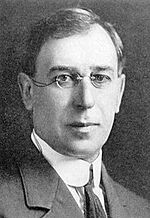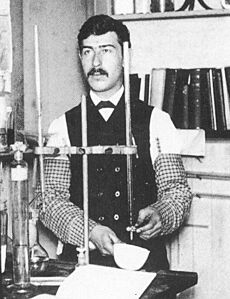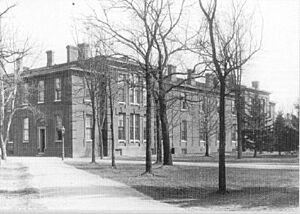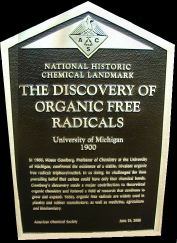Moses Gomberg facts for kids
Quick facts for kids
Moses Gomberg
|
|
|---|---|

Moses Gomberg, the father of radical chemistry
|
|
| Born | February 8, 1866 Yelizavetgrad, Russian Empire [now Kropyvnytskyi, Ukraine]
|
| Died | February 12, 1947 (aged 81) Ann Arbor, Michigan, United States
|
| Alma mater | University of Michigan B.S., 1890, M.S., 1892, Ph.D., 1894 |
| Known for | Radical chemistry |
| Awards | William H. Nichols Medal (1914) Willard Gibbs Award (1925) Chandler Medal (1927) |
| Scientific career | |
| Fields | chemistry |
| Institutions | University of Michigan |
| Doctoral advisor | A. B. Prescott |
Moses Gomberg (born February 8, 1866 – died February 12, 1947) was an important chemistry professor. He taught at the University of Michigan for many years. He is famous for discovering a new type of chemical particle called a "radical." This discovery helped create a whole new area of chemistry. He was also the president of the American Chemical Society.
Contents
Early Life and Education
Moses Gomberg was born in 1866 in a place called Yelizavetgrad. This city was part of the Russian Empire, but it is now in Ukraine. His family was Jewish. In 1884, his family moved to Chicago, USA. They left Russia to escape violence against Jewish people, known as pogroms.
In Chicago, Moses worked at the stockyards. He also went to Lake High School. In 1886, he started studying at the University of Michigan. He earned his first degree in 1890. Then, he got his Ph.D. in chemistry in 1894. His Ph.D. project was about making new forms of caffeine.
Career and Discoveries
Moses Gomberg started working at the University of Michigan in 1893. He stayed there for his entire career. From 1927 until he retired in 1936, he was the head of the chemistry department. In 1931, he was also the president of the American Chemical Society.
In 1896 and 1897, Gomberg took a year off. He traveled to Europe to work with other famous chemists. He worked with scientists like Adolf von Baeyer and Victor Meyer. During this time, he successfully made a complex molecule called tetraphenylmethane.
Discovering Chemical Radicals
Gomberg tried to make an even more complex molecule. He was working with a chemical called triphenylmethyl chloride. During his experiments, he accidentally discovered something new. He found a special kind of chemical particle called the triphenylmethyl radical.
This was a huge discovery! It was the first time anyone had found a "persistent radical." Radicals are very reactive particles. Gomberg's discovery made him known as the founder of "radical chemistry." This field studies how these special particles behave.
Later, Gomberg worked with another chemist, Werner Emmanuel Bachmann. Together, they discovered a chemical reaction now called the Gomberg-Bachmann reaction. This reaction is still used today to make certain types of chemicals.
How He Discovered Radicals
Gomberg was trying to make a molecule called hexaphenylethane. He used a method called a Wurtz coupling. But when he checked his new chemical, it didn't match what he expected. The amount of carbon and hydrogen was different.
He thought that his chemical might have reacted with oxygen from the air. This led him to realize he had made a "free radical." A free radical is a molecule with an unpaired electron. This makes it very reactive.
Gomberg showed that his new compound reacted easily with air and other chemicals like chlorine. He believed he had found the first example of a persistent radical. This idea was quite new and debated for many years. Scientists later learned that the radical existed in a balance with another form.
At the end of his first report about his discovery, Gomberg wrote that he wanted to keep working on this field himself. But the field of radical chemistry grew so quickly that many other scientists joined in.
Legacy
When Moses Gomberg passed away in 1947, he left his money to the University of Michigan's chemistry department. This money helps create scholarships for students.
In 2000, a special event was held to celebrate 100 years since his paper "Triphenylmethyl, a Case of Trivalent Carbon." A plaque was placed in the Chemistry Building at the University of Michigan. It marks his discovery as a National Historic Chemical Landmark.
Since 1993, the University of Michigan has a special lecture series named after Moses Gomberg. It allows young professors to invite important scientists to speak about chemistry.
Personal Life
Moses Gomberg never married. He lived with his sister, Sophia, in Ann Arbor, Michigan, for most of his adult life.




